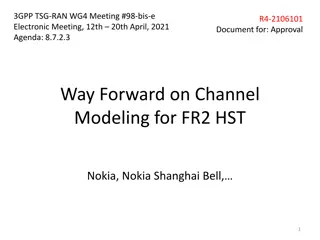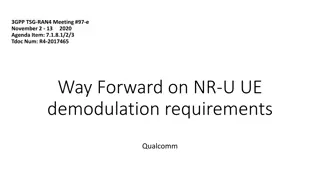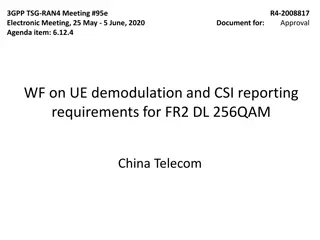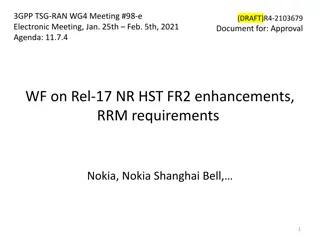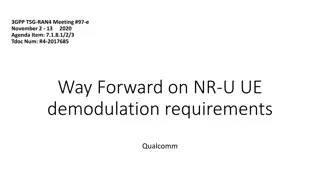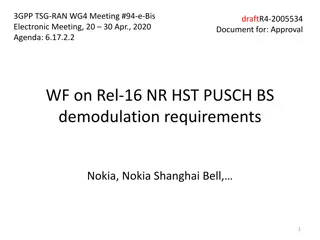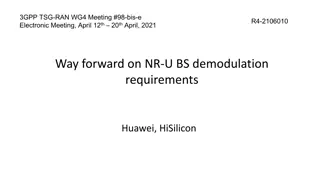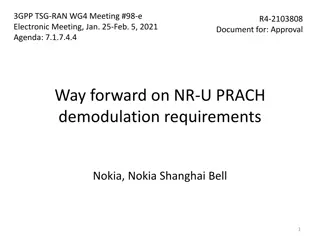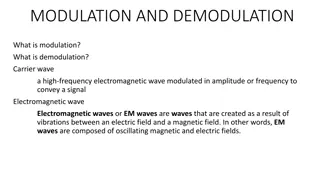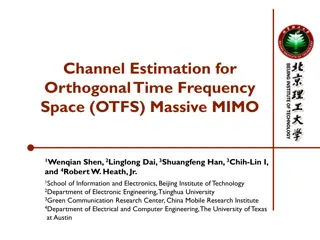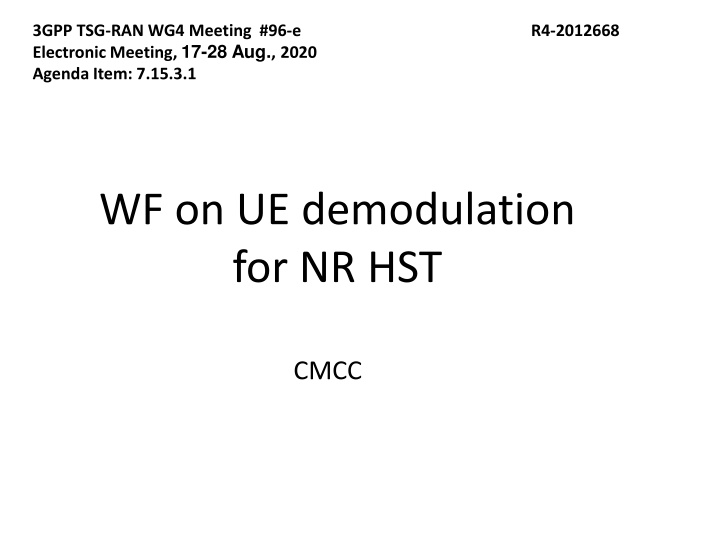
Test Cases and Setup for DPS Transmission in 3GPP TSG-RAN Meeting
Explore test cases and setup considerations for DPS transmission scheme 1b discussed in the 3GPP TSG-RAN WG4 Meeting #96-e. Understand options for UE demodulation and testing guidelines for NR HST CMCC. Dive into the detailed test case scenarios and setups for DPS scheme 1a, covering RRH configurations, TCI states, PDSCH and CSI configurations, and more.
Download Presentation

Please find below an Image/Link to download the presentation.
The content on the website is provided AS IS for your information and personal use only. It may not be sold, licensed, or shared on other websites without obtaining consent from the author. If you encounter any issues during the download, it is possible that the publisher has removed the file from their server.
You are allowed to download the files provided on this website for personal or commercial use, subject to the condition that they are used lawfully. All files are the property of their respective owners.
The content on the website is provided AS IS for your information and personal use only. It may not be sold, licensed, or shared on other websites without obtaining consent from the author.
E N D
Presentation Transcript
3GPP TSG-RAN WG4 Meeting #96-e Electronic Meeting, 17-28 Aug., 2020 Agenda Item: 7.15.3.1 R4-2012668 WF on UE demodulation for NR HST CMCC
Background The following WFs were approved: R4-1910050 WF on demodulation for UE NR HST, RAN4#92 R4-1912808 Way forward on NR HST UE demodulation, RAN4#92BIS R4-1915926 WF on UE demodulation for NR HST, RAN4#93 R4-2002418 WF on UE demodulation for NR HST, RAN4#94-e R4-2005532 WF on UE demodulation for NR HST, RAN4#94bis-e R4-2008820 WF on UE demodulation for NR HST, RAN4#95-e
Test case for DPS Whether to introduce test cases for DPS transmission scheme 1b Introduce DPS transmission scheme 1b test cases with test applicable rules which can be further discussed among below options Option 1: If UE declared supporting > 1 TCI states, UE will pass scheme 1b and skipped HST single tap test cases and scheme 1a test cases If UE only support 1TCI state, UE need to pass both scheme 1a and HST single tap test cases and skip scheme 1b test cases Option 2: If UE pass HST-SFN test cases, then UE can skip HST-DPS scheme 1a/1b
Test setup for DPS 1a 1. Two RRH s of RRH#(2k) and RRH#(2k+1) are assumed, and SSB#0 is transmitted from both TRPs, where k is the RRH number with k=0,1, 2, UE is configured with TCI#(k mod 2) and TCI#(k+1 mod 2) that are associated with TRS#(k mod 2) and TRS#(k+1 mod 2) transmitted from RRH#(2k) and RRH#(2k+1) respectively by RRC signalling tci-StatesToAddModList in the PDSCH-Config and tci- PresentInDCI is not configured; All the configured TCI states are known to UE. UE is configured with NZP-CSI-RS resource for L1-RSRP measurements by RRC signaling nzp-CSI-RS-ResourceSet within the CSI- ResourceConfig and periodic CSI reporting by setting reportConfigType to periodic and reportQuantity to cri-RSRP (Note: reported L1-RSRP mesurements are not tested) TE actives TCI #0 for PDCCH by TCI State Indication for UE-specific PDCCH MAC CE ; PDSCH associated with TCI #0 is transmitted during the slots from 0 to (n-1) + HARQ needed time + 3ms + first TRS + TRS processing time; In slot n TE start triggering TCI state switching command to TCI #1 by TCI State Indication for UE-specific PDCCH MAC CE ; PDSCH associated with TCI #1 is transmitted in slots from n + HARQ needed time + 3ms + first TRS + TRS processing time to N. 2. 3. 4. 5. PDSCH associated with TCI #(k mod 2) (k=0,1,2, ) is transmitted in slot from max((2k-1)n, 0) to ((2k+1)n-1) + HARQ needed time + 3ms + first TRS + TRS processing, where n slots are equivalent to time that needed to pass middle point between two RRHs, N slots is equivalent to time that needed to pass second RRH. And k is the RRH number in the channel model.
Test parameters for DPS Transmission scheme 1a Rank 2 PDSCH is scheduled in DL, FFS for special slots TRS processing time: 2ms MCS Option 1: MCS 13 based on 64QAM table (same as HST-SFN) Option 2: MCS 17 based on 64QAM tables HARQ timing FDD 15kHz SCS: 2 slots TDD 30kHz SCS with TDD pattern 7D1S2U: {8,7,6,5,5,4,3,2} slots
Open issues for DPS Number of active TCI states in DPS transmission scheme 1b Option 1: with 2 active TCI states. Option 2: with 2 and more than 2 active TCI states. FFS Test setup of DPS 1b Statistics during the switching time for both DPS 1a and 1b Option 1: The switch command is transmitted via MAC CE, the corresponding PDSCH carrying that MAC CE should be ensured to be decoded successfully and lower MCS should be used, such as MCS 4. Option 2: PDCCH/PDSCH are DTXed from the time gNB indicates MAC CE TCI state switch to the time UE receive the first TRS from the new TRP. Option 3: Use same SNR point for all DPS Tx schemes requirements definition: Skip PDSCH allocation on slots with TRS transmission Skip PDSCH allocation on slots from n to m, where n slots are equivalent to time that needed to pass middle point between two RRH and m is a slot which corresponds to HARQ needed time on MAC CE command in DPS scheme 1a. Other options are not precluded.
Test setup of DPS 1b Test setup for transmission scheme 1b Use following as baseline for DPS transmission scheme 1b test setup (agreement in last meeting) for scenario with 2 active TCI states (total 2 active TCI states): PDCCH TCI state switching delay caused by MAC CE, but less than DPS 1a with pre-tracking of second TCI state and only HARQ needed time + 3ms delay is needed, UE tracks 2 active TCI states in advance so that UE can quickly get better Doppler shift estimation for the second TRP compared to DPS 1a. 1. UE is configured with two different TCI states (TCI #0 and TCI #1) associated with two different RRHs by RRC signalling tci-StatesToAddModList in the PDSCH-Config and tci- PresentInDCI is not configured; 2. TE activates TCI #0 and TCI #1 for PDSCH at the same time by TCI States Activation/Deactivation for UE-specific PDSCH MAC CE and activates TCI #0 for PDCCH by TCI State Indication for UE-specific PDCCH MAC CE command with the field of CORESET ID set to 0; 3. TE transmits PDCCH and PDSCH associated with TCI #0 from TRP#1 from slot 0 to n-1; 4. In slot n TE start triggering TCI state switching command to TCI #1 by TCI State Indication for UE-specific PDCCH MAC CE ; 5. TE transmits PDCCH and PDSCH associated with TCI #1 from TRP#2 from slot n [+ HARQ needed time + 3ms] to N. where n slots are equivalent to time that needed to pass middle point between two RRHs, N slots is equivalent to time that needed to pass second RRH
Test setup of DPS 1b cont., Test setup for transmission scheme 1b Use following as baseline for DPS transmission scheme 1b test setup (agreement in last meeting) for scenario with 3 active TCI states (Total 3 active TCI states): No PDCCH TCI state switching delay by using MAC CE, but 3 active TCI states to track, UE needs to report supporting of maxNumberActiveTCI-PerBWP = n4 1. UE is configured with three different TCI states (TCI #0, TCI #1 and TCI #2) associated with two different RRHs by RRC signalling tci-StatesToAddModList in the PDSCH-Config; 2. TE activates TCI #0 and TCI #1 for PDSCH at the same time by TCI States Activation/Deactivation for UE-specific PDSCH MAC CE and activates TCI #2 for PDCCH by TCI State Indication for UE-specific PDCCH MAC CE command with the field of CORESET ID set to 0; 3. TE transmits PDCCH associated with TCI#2 from TRP#1 and TRP#2 from slot 0 to N 4. DCI contains pointer to TCI#0 from slot 0 to n-1 and pointer to TCI#1 from slot n to N 5. TE transmits PDSCH associated with TCI #0 from TRP#0 from slot 0 to n-1 6. TE transmits PDSCH associated with TCI #1 from TRP#1 from slot [n or n+1] to N where n slots are equivalent to time that needed to pass middle point between two RRHs, N slots is equivalent to time that needed to pass second RRH
Applicability rule Test applicability between HST-SFN and HST single tap Do not test UE under HST single-tap, if UE passes the requirements for HST-SFN. Option 1: Skip the Rel-15 HST single tap test, if UE passes the requirements for HST-SFN Option 2: Skip both Rel-15 and Rel-16 HST single tap test, if UE passes the requirements for HST-SFN Test applicability between HST-SFN and HST multi-path fading Option 1: Do not test UE under HST multi-path scenarios, if UE passes the requirements for HST-SFN. Option 2: Do not define any applicability rules between HST-SFN and HST multi-path fading performance test cases
Applicability rule Test applicability between different Doppler frequencies for the same channel model For FDD Define applicability rule for TDLB100-400 Rel-15 multi-path fading with TDLB100-400 (Table 5.2.2.1.1-3 Test 1-1 and Table 5.2.3.1.1-3 Test 1-1) is not applicable for UE that passes Rel-16 multi-path fading tests TDLC300-600 for FDD FFS whether to define applicability rule for TDLC300-100 Option 1: no applicability rule Option 2: Rel-15 multi-path fading with TDLC300-100 (Table 5.2.2.1.1-3 Test 1-2 and Table 5.2.3.1.1-3 Test 1-2) is not applicable for UE that passes Rel-16 multi-path fading tests TDLC300-600 for FDD
Applicability rule Test applicability between different Doppler frequencies for the same channel model For TDD Not define any applicability rule for TDLB100-400 multi-path fading tests between Rel-15 and FFS whether to define applicability rule for TDLC300-100 Option 1: no applicability rule Option 2: Rel-15 multi-path fading with TDLC300-100 (Table 5.2.2.2.1-3 Test 1-2 and Table 5.2.3.2.1-3 Test 1-2) is not applicable for UE that passes Rel-16 multi-path fading tests TDLC300-1200 for TDD
Release independent Rel-16 HST-SFN requirements are released independent from Rel-15 HST-DPS test is release independent from Rel-15
Simulation assumption for DPS transmission scheme Parameter Value FDD 15KHz SCS TDD 30KHz SCS Antenna configuration DMRS type Number of DMRS symbols 2x2; 2x4 type 1 DMRS 1+1+1 TDD pattern 7D1S2U, FFS whether PDSCH is scheduled in special slots MCS Option 1: MCS 13 based on 64QAM table Option 2: MCS 17 based on 64QAM table HST-DPS (Assume two TRPs for HST-DPS transmission scenario) 10ms, 2slot pattern Type A, Start symbol 2, Duration 12 Ds=700m, Dmin=150m Rank = 2 10MHz 870Hz 2 Propagation condition TRS periodicity PDSCH mapping Ds and Dmin Rank BW Maximum Doppler shift HARQ needed time/slots TRS processing time Testing metric Note: The other parameters are same as Rel-15 40MHz 1667Hz 8,7,6,5,5,4,3,2 2ms SNR @70% of maximum throughput
Simulation assumption for HST-SFN Parameter Value FDD 15KHz SCS TDD 30KHz SCS Antenna configuration DMRS type Number of DMRS symbols 2x2; 2x4 type 1 DMRS 1+1+1 TDD pattern 7D1S2U, S: 6D 4G 4U MCS MCS 13 based on 64QAM table HST-SFN 10ms, 2slot pattern Type A, Start symbol 2, Duration 12 Ds=700m, Dmin=150m Rank = 2 10MHz 870Hz SNR @70% of maximum throughput Propagation condition TRS periodicity PDSCH mapping Ds and Dmin Rank BW Maximum Doppler shift Testing metric 40MHz 1667Hz Note: The other parameters are same as Rel-15
Simulation assumption for HST-single tap Parameter Value FDD 15KHz SCS TDD 30KHz SCS Antenna configuration DMRS type Number of DMRS symbols 1x2; 1x4 type 1 DMRS 1+1+1 MCS MCS 17 based on 64QAM table 7D1S2U, S: 6D 4G 4U HST-single tap 10ms, 2slot pattern Type A, Start symbol 2, Duration 12 Ds= 300m, Dmin=2m Rank = 1 10MHz 972Hz TDD pattern Propagation condition TRS periodicity PDSCH mapping Ds and Dmin Rank BW Maximum Doppler shift 40MHz 1667Hz Testing metric SNR @70% of maximum throughput Note: The other parameters are same as Rel-15
Simulation assumption for multi-path fading channel Parameter Value FDD 15KHz SCS TDD 30KHz SCS Antenna configuration DMRS type Number of DMRS symbols 2x2; 2x4 type 1 DMRS 1+1+1 TDD pattern 7D1S2U, S: 6D 4G 4U MCS MCS 13 based on 64QAM table TDL-C 300ns 10ms, 2slot pattern Type A, Start symbol 2, Duration 12 Rank = 1 10MHz 600Hz SNR @70% of maximum throughput Propagation condition TRS periodicity PDSCH mapping Rank BW Maximum Doppler shift Testing metric 40MHz 1200Hz Note: The other parameters are same as Rel-15

